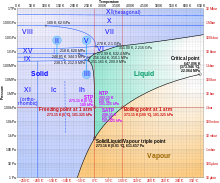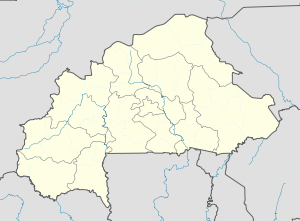아이스c 1
Ice IcIce Ic("얼음 원 c" 또는 "얼음 I see"로 발음됨)는 측정 가능한 입방체 결정체 변형 얼음이다. 한스 쾨니그는 얼음 1의c 구조를 가장 먼저 파악하고 추론했다.[1] 얼음 I의c 산소 원자는 다이아몬드 구조로 배열되어 있으며 거의 동일한 밀도와 육각형 푸커플레인을 따라 같은 격자 상수를 가진 얼음 I와 매우h 유사하다.[2] 냉각 시 130~220 켈빈(-143도 및 -53도)의 온도에서 형성되며, 얼음 I로h 변환할 [3][4]때 온난화 시 최대 240K(-33°C)까지 존재할 수 있다.
과냉각수로부터 형성되는 것 외에도,[5] 얼음 I는c 또한 고압의 icce[2] II, III, V로부터도 비정형 얼음으로부터 형성되는 것으로 보고되었다.[6] 그것은 형성될 수 있고 가끔 상층 대기[7] 중에 존재하며, 태양이나 달에서 28도 가까이 발생하는 희귀한 고리인 스키너의 후광을 관찰하는 데 책임이 있다고 여겨진다.[8]
보통의 물 얼음은 얼음h I(브리지그만 명명법에서)로 알려져 있다. ice II에서 ice XIX에 이르기까지 다양한 종류의 얼음이 다른 온도와 압력으로 실험실에서 생성되었다.[9]
일부 저자들은 얼음c I("얼음 I")[10][11][12]가 단지 쌓여서 분해된 얼음 I"에sd 불과하다고 주장하며 내가 정말로 세제곱 결정 체계를 가지고 있는지에 대해 의문을 표시했으며, 그것은 문자 그대로 보다 일반적인 의미로 "가장 면적인 얼음 단계"로 불렸다.″[13]
참고 항목
- Ice I, 얼음의 다른 결정체 형태용
참조
- ^ König, H. (1943). "Eine kubische Eismodifikation". Zeitschrift für Kristallographie (in German). 105 (1): 279–286. doi:10.1524/zkri.1943.105.1.279. S2CID 101738967.
- ^ a b Dowell, L. G.; Rinfret, A. P. (December 1960). "Low-Temperature Forms of Ice as Studied by X-Ray Diffraction". Nature. 188 (4757): 1144–1148. Bibcode:1960Natur.188.1144D. doi:10.1038/1881144a0. ISSN 0028-0836. S2CID 4180631.
- ^ Murray, B.J.; Bertram, A. K. (2006). "Formation and stability of cubic ice in water droplets". Phys. Chem. Chem. Phys. 8 (1): 186–192. Bibcode:2006PCCP....8..186M. doi:10.1039/b513480c. hdl:2429/33770. PMID 16482260.
- ^ Murray, B.J. (2008). "The Enhanced formation of cubic ice in aqueous organic acid droplets". Environmental Research Letters. 3 (2): 025008. Bibcode:2008ERL.....3b5008M. doi:10.1088/1748-9326/3/2/025008.
- ^ Mayer, E.; Hallbrucker, A. (1987). "Cubic ice from liquid water". Nature. 325 (12): 601–602. Bibcode:1987Natur.325..601M. doi:10.1038/325601a0. S2CID 4233237.
- ^ Bertie, J. E.; Calvert, L. D.; Whalley, E. (1963). "Transformations of Ice II, Ice III, and Ice V at Atmospheric Pressure". J. Chem. Phys. 38 (4): 840–846. Bibcode:1963JChPh..38..840B. doi:10.1063/1.1733772.
- ^ Murray, Benjamin J.; Knopf, Daniel A.; Bertram, Allan K. (March 2005). "The formation of cubic ice under conditions relevant to Earth's atmosphere". Nature. 434 (7030): 202–205. Bibcode:2005Natur.434..202M. doi:10.1038/nature03403. ISSN 0028-0836. PMID 15758996. S2CID 4427815.
- ^ Whalley, E. (1981). "Scheiner's Halo: Evidence for Ice Ic in the Atmosphere". Science. 211 (4480): 389–390. Bibcode:1981Sci...211..389W. doi:10.1126/science.211.4480.389. PMID 17748273.
- ^ Flatz, Christian; Hohenwarter, Stefan. "Neue kristalline Eisform aus Innsbruck". Universität Innsbruck (in German). Retrieved 2021-02-18.
- ^ Murray, Benjamin J.; Salzmann, Christoph G.; Heymsfield, Andrew J.; Dobbie, Steven; Neely, Ryan R.; Cox, Christopher J. (2015). "Trigonal Ice Crystals in Earth's Atmosphere" (PDF). Bulletin of the American Meteorological Society. 96 (9): 1519–1531. Bibcode:2015BAMS...96.1519M. doi:10.1175/BAMS-D-13-00128.1.
- ^ Chaplin, Martin (15 September 2019). "Stacking disordered ice; Ice Isd". Water Structure and Science. London South Bank University. Archived from the original on 22 Oct 2020. Retrieved 3 December 2019.
- ^ Malkin, Tamsin L.; Murray, Benjamin J.; Salzmann, Christoph G.; Molinero, Valeria; Pickering, Steven J.; Whale, Thomas F. (2015). "Stacking disorder in ice I". Physical Chemistry Chemical Physics. 17 (1): 60–76. doi:10.1039/C4CP02893G. PMID 25380218.
- ^ Kuhs, W. F.; Sippel, C.; Falenty, A.; Hansen, T. C. (2012). "Extent and relevance of stacking disorder in "ice Ic"". Proceedings of the National Academy of Sciences of the United States of America. 109 (52): 21259–21264. Bibcode:2012PNAS..10921259K. doi:10.1073/pnas.1210331110. PMC 3535660. PMID 23236184.



